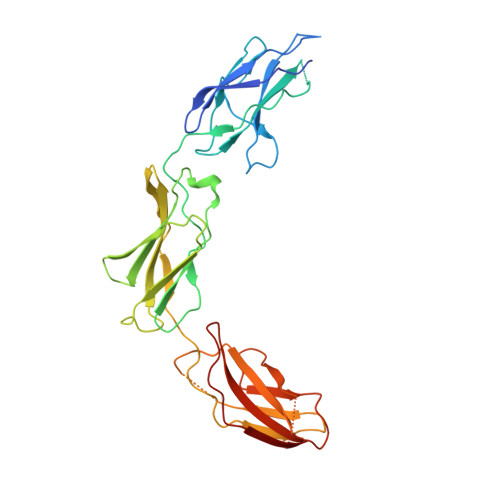Members of the vertebrate contactin and amyloid precursor protein families interact through a conserved interface.
Karuppan, S.J., Vogt, A., Fischer, Z., Ladutska, A., Swiastyn, J., McGraw, H.F., Bouyain, S.(2021) J Biological Chem 298: 101541-101541
- PubMed: 34958801
- DOI: https://doi.org/10.1016/j.jbc.2021.101541
- Primary Citation of Related Structures:
7MQY, 7MRK, 7MRM, 7MRN, 7MRO, 7MRQ, 7MRS - PubMed Abstract:
Contactins (CNTNs) are neural cell adhesion molecules that encode axon-target specificity during the patterning of the vertebrate visual and olfactory systems. Because CNTNs are tethered to the plasma membrane by a glycosylphosphatidylinositol anchor, they lack an intracellular region to communicate across the membrane. Instead, they form coreceptor complexes with distinct transmembrane proteins to transmit signals inside the cell. In particular, a complex of CNTN4 and amyloid precursor protein (APP) is known to guide the assembly of specific circuits in the visual system. Here, using in situ hybridization in zebrafish embryos, we show that CNTN4, CNTN5, and the APP homologs, amyloid beta precursor like protein 1 and amyloid beta precursor like protein 2, are expressed in olfactory pits, suggesting that these receptors may also function together in the organization of olfactory tissues. Furthermore, we use biochemical and structural approaches to characterize interactions between members of these two receptor families. In particular, APP and amyloid beta precursor like protein 1 interact with CNTN3-5, whereas amyloid beta precursor like protein 2 only binds to CNTN4 and CNTN5. Finally, structural analyses of five CNTN-amyloid pairs indicate that these proteins interact through a conserved interface involving the second fibronectin type III repeat of CNTNs and the copper-binding domain of amyloid proteins. Overall, this work sets the stage for analyzing CNTN-amyloid-mediated connectivity in vertebrate sensory circuits.
- Department of Cell and Molecular Biology and Biochemistry, School of Biological and Chemical Sciences, University of Missouri-Kansas City, Kansas City, Missouri, USA.
Organizational Affiliation:

















